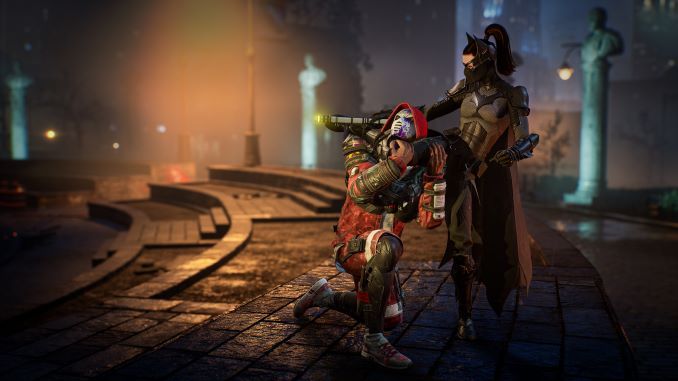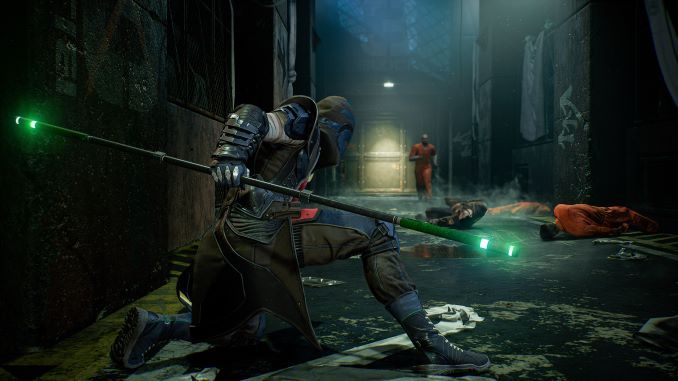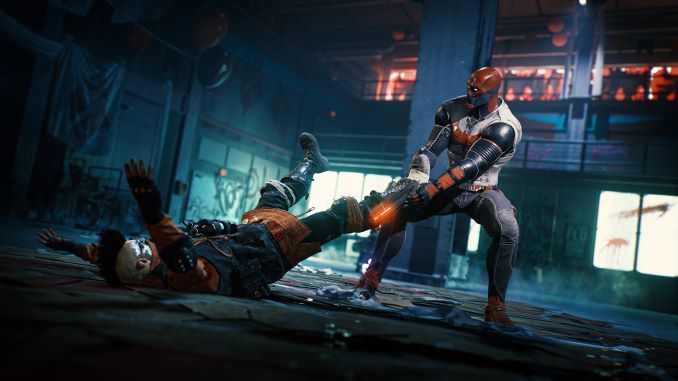Gotham Knights Tries To Break Out from the Arkham Series’ Shadow, But Is It Enough?
Games Features Gotham Knights
At first glance, Gotham Knights appears to have a lot in common with the much-beloved Batman: Arkham series. Its combat is at least superficially similar, a rhythmic affair where enemies have big wind-up animations and eye-catching UI popups offer indicators for when to perform an acrobatic dodge. When you’re not punching people, you’ll sneak around by grappling between elevated hidden perches until you get the perfect angle to do a stealthy takedown and slink back into the shadows. Like entries after Arkham City, the streets of Gotham are yours to explore and defend, somehow filled with endless bands of criminals. During detective sequences, you switch to an x-ray scanner and find pieces of evidence. It is even being developed by WB Games Montreal, who previously worked on Batman: Arkham Origins. While many of these elements can be found in plenty of other AAA action games, there is a specific cadence to the Arkham games that made them feel relatively unique.
But despite its many similarities, Gotham Knights is not a new entry in the Arkham series. In fact, it doesn’t even follow Batman. Mostly because he is dead. The game takes place after the demise of the caped crusader, as his disciples Nightwing, Batgirl, Red Hood, and Robin scramble to fill the void left by their mentor. But they aren’t the only ones filling a power vacuum, and many of Gotham’s familiar villains (Penguin, Harley, etc.) rush to take advantage of the city’s new vulnerabilities. His four proteges form the Gotham Knights to combat this threat and uncover who killed Batman.
Unsurprisingly based on this premise, the first notable difference compared to previous games is you play as the Knights instead of Batman. Each has unique abilities and strengths. Robin has enhanced stealth abilities, Batgirl is tanky and can deploy a drone, Nightwing can perform gymnastic maneuvers to launch himself off enemies, and Red Hood has a gun. You can switch between them at the Belfry, your home base, where you can upgrade abilities, talk to teammates, and prepare for the next mission.

But arguably, Gotham Knights’s most important distinction is it seems to take inspiration from games like The Division and Destiny. It is at least partially designed around co-op play, which explains the multiple characters. It also heavily emphasizes RPG mechanics like leveling, loot, and having a billion different currencies for crafting. While I’m unclear on how much Knights is intended to be a GAAS (Games As A Service) experience versus how much it’s simply leaning into the RPG-ification of AAA games, I imagine many of these elements may be polarizing. GAAS title or not, it seems on the trajectory of other checklist-oriented big-budget titles designed around stuffing as much similar “content” into the experience as possible to increase hour counts and retain players. The days when tightly designed AAAs like Arkham Asylum were the norm feels like an eternity ago, and it seems unlikely Knights will buck the trends that even later Arkham games caved to.
In terms of its RPG-ness, I will say that although numbers fly out of enemies’ heads as you pummel them and you can find weapons with different colors attached to their rarity, the game’s skill tree was in line with most other open-world big-budget titles. There is also still an emphasis on story missions with areas that feel designed for that specific turn of the narrative (at one point during Harley Quinn’s questline, an elaborately staged prison brawl broke out to a cover of “Livin’ La Vida Loca”). You can explore Gotham through ziplining, gliding, and driving to discover various side missions and chance encounters. All of this looks and feels like exactly what you would expect from an expensive modern open-world game.
Where things feel more distinct from what came before, and perhaps where I am the most unconvinced about the new direction, is the battles. In terms of similarities, there is still an emphasis on beating down large numbers of goons while rhythmically hitting the X button (if you’re on an Xbox controller) until you see an attack indicator over an enemy’s fist and hit B to leap out of the way. Little variations can be found with beefier foes that require a charged blow to break their defenses or ranged opponents that huck Molotov cocktails in your direction (after a large red visual prompt makes the incoming projectile very clear).

The most significant difference is the emphasis on the Momentum meter, which lets you unleash powerful unique moves when filled. For instance, Batgirl can release a persistent drone, Red Hood lets loose a volley of gunshots that interrupt enemies, and Nightwing can apply buffs to himself and his team. While using these abilities feels satisfying, and there is some degree of strategy involved, such as using a guard-break on a defensive opponent or a piercing strike against incoming multi-hitting moves, the problem is that it feels like most of the characters’ kits are gated behind this system. Without these maneuvers, your options feel painfully quite restrictive. At least where I was in the game, it seemed like the only non-Momentum offensive techniques were normal and charged attacks, ranged moves, and a grab if the opponent was injured. While the meter does fill fairly fast, and you eventually unlock additional bars that let you unleash Momentum actions in rapid succession, putting all of these cool abilities behind a resource makes it feel more like I’m playing an MMO than a successor to one of the better combat systems in recent memory.
Another big step back is that attacks did not feel nearly as substantive as in previous titles. One of the defining elements of the Arkham games is that when you landed a blow, the percussive strength of your strike made it clear that Batman was a roided-out beef house with several-inch thick forearms. That feeling of power seems to have disappeared alongside our deceased hero.
Still, there were a few new elements I did enjoy. Each character felt somewhat unique thanks to their special moves and upgrade trees, which boosted specific stats and facets of their play. Thankfully, each Knight levels up even if you’re not using them actively, meaning you can switch who you’re playing between missions to add some variety. I had some exciting moments during my demo that highlighted the distinctions between the four, such as when I realized that Red Hood’s ability to aim down sights using his pistols transformed the action combat into a surprisingly satisfying shooter (this may have also been because I was equipped with seemingly busted electric-infused guns). The new systems came together somewhat during the demo’s climatic final boss fight against Harley Quinn. Here I strafed between brainwashed stooges while blasting them with (non-lethal) bullets so I could feed by Momentum meter and unleash my strongest moves to interrupt Harley’s damaging attack strings.
Additionally, what I saw of the game’s writing seemed solid enough. As made clear in some of these characters’ mournful conversations, this appears to be a story about coming to terms with the loss of Batman, both for the heroes and villains. While frequent quips and witticism mean it’s not as tonally dire as something like The Batman, there are some intriguing narrative elements, like how the Knights are each working through their complicated relationship with their deceased mentor.
Only so much can be taken from a two-and-a-half-hour vertical slice of what will presumably be a fairly long experience, but what I saw of Gotham Knights did little to allay my fears that the game will replicate trends I personally don’t care for in the AAA space. Elements like how you seemingly can’t pause in the open world because you may be playing co-op (even if you aren’t), the emphasis on loot, the prevalence of cooldowns, and the seeming prioritization of having more “content” over a more precisely curated experience all left me slightly pessimistic. But to be honest, regardless of if Gotham Knights shapes up to be the next hit AAA Action RPG or if it is a pale imitation of Destiny, my time with the demo left me looking back at Arkham Asylum and its generation of big-budget games with increasingly rose-tinted glasses.
This is based on a two-and-a-half hour hands-on demo of Gotham Knights.
Elijah Gonzalez is the games intern for Paste Magazine. In addition to playing the latest indies and AAAs, he also loves film, anime, lit, and creating large lists of media he’ll probably never actually get to. You can follow him on Twitter @eli_gonzalez11.